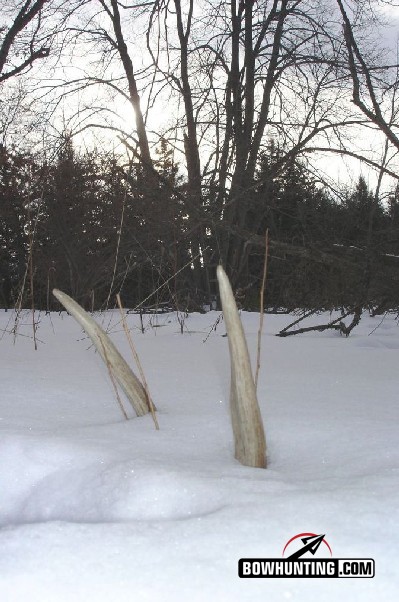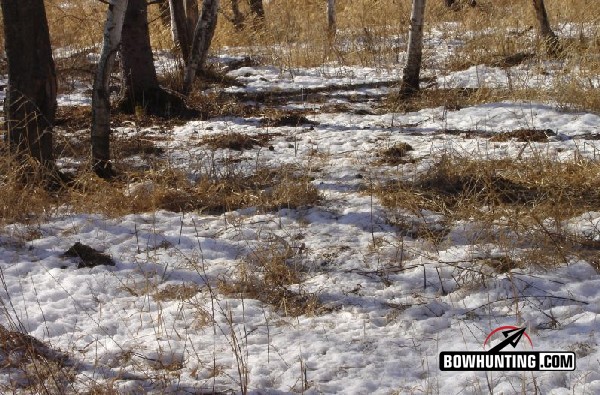LAST UPDATED: May 8th, 2015
Shed antler hunting can sometimes best be described as a search for a needle in a haystack, a really big haystack! We all try it, or make our best attempts to, with sometimes great and/or limited success. But why? Why are some shed hunters so very successful at this new found pastime and others so, dare we say it, inept? Perhaps ill-informed is a better way to describe those that struggle finding these treasures which shed from our favorite game species every year.
Shed hunting has become extremely popular over the past decade, and rightfully so, as it helps further our cultural obsession to know and understand more about the very game we hunt. Sometimes even to the point of just a particular animal that we desire. It can help us become better woodsman, better friends, and even better stewards of the land. Shed hunting today is part of the 365 day modern hunters’ arsenal.
Where to look:
Finding a shed antler is not always about getting out to just any piece of ground. It’s a numbers game, and you’ll have better odds of picking 1 or 2 up if you are looking where larger populations of bucks have spent the late winter or early spring.
Start with the food.
The preferred food sources, and nearby them, are where you are likely to find the most sheds this or any season. These food sources include corn, hay, bean, even milo fields. Where snowfall is less of a factor or these food sources are rare, solid acorn mast and/or browse within the woods can often produce a few whitetail sheds for the hunter. It is important to understand that not all food sources are created equally. Factors include adequate bedding proximity and, like hunting, sometimes human and/or other predator pressures.
The food sources that are closest to good winter bedding areas are often best. They must offer some sort of visual protection for the whitetail, a place to get out of the wind, and often a place in which the suns rays can hammer on throughout most of the day. Pay special attention to deadfalls and/or hillsides that face the southern or eastern skies as they will see much more of the shortened day’s sun. In big swamp country, small islands within cattails and the outside edges are often the best place to look for a bedded buck in winter’s months. Same goes for his sheds.
A popular way to seek out which food sources are holding the greatest numbers of deer is through visual scouting. Many shed hunters simply drive around much of late winter searching and scanning over nearby fields. Armed with a good pair of binoculars, these shed hunters will note which fields are seeing the most amount of deer traffic, and more importantly, buck traffic. It’s within these fields that most of these shed hunters will start their hunt for shed antlers within the following weeks.
Where food sources are limited or deer populations are high, whitetail sheds like the one pictured above, can often be found in or on the edges of CRP fields.
What to look for:
Seasoned shed hunters know that looking first for color is a very deceiving practice while searching for shed antlers. Mainly because shed antlers can have so many different hues ranging from darker browns, into yellows, and a frosty white. These colors can hide very effectively in fields of cut corn or shaded downfalls, places where these antlers are so often found.
Most shed hunters agree that it’s best to search for the sharp curves or points of a shed. Keeping ones vision out away from you between 5 and 20 yards while walking, constantly reminding yourself what you are looking for. This is important while shed hunting since so many of us are animal hunters as well. Often, a want to look around for other deer sign like scrapes or rubs can be an antler seeker’s worst enemy.
Below you will find a small selection of “as they lay” pictures of whitetail antlers. These pictures are a perfect example of what you are looking for in your fields or woods. Notice the sharp points, and/or curves. They are noticeably different when compared with the grasses, leaves, and timber edges which surround them.
Pictured above, this antler was the only sharper object in a sea of dried CRP grasses.

On a overcast day in early February, this antler’s sharp tines almost glow against a backdrop of leaves.

When to go shed hunting:
Certainly time restraints have great impact on any individual who is seeking a good day in the field shed hunting. However, certain weather conditions exist which can help or impair any antler seeker.
Extremely sunny days with high skies can be the most difficult days for a hike. These days cast heavy shadow into the woods and fields even, making it very difficult to spot antler tines from greater distances. Cloudy, overcast conditions are much more suitable for antler hunting. If you must go on a sunnier day, leave earlier and search just before the sun has risen high enough to cast a good shadow. Or search in the last couple hours of daylight when antlers begin to almost glow with the setting sun.
Conditions where rain has just fallen over several hours followed by grey skies are perhaps the shed hunters’ best friend. These conditions often make the antler shine brightly in fields and woodlots. Antlers in these conditions can really stick out, sometimes being seen from 30 yards or more!
Even darker colored antlers can almost GLOW after sitting out in the rain for several hours. These wet conditions make for a shed antler hunters best friend.
What the shed antler can tell you.
Shed antlers are the fingerprints of a whitetail buck. Unlike the rub, the scrape, or a giant bed, a shed antler is specific to the animal that has left it there. It can help us determine a more accurate age, certain tendencies, and even particular patterns of a specific buck. Combined with modern trail camera pictures, these antlers can have a grave impact on discerning a particular whitetail’s true home range, sometimes even his preferred bedding sites. In all, they can help us become a better, more understanding big game hunter.
Bowhunting.com staff and its readers are always interested in your take on shed antler hunting. Do you feel it can better help you as a hunter? And what, if any, tips can you give to fellow shed hunters in order for them to succeed more each day while seeking out this earthly treasure.
Please leave your comments below.






